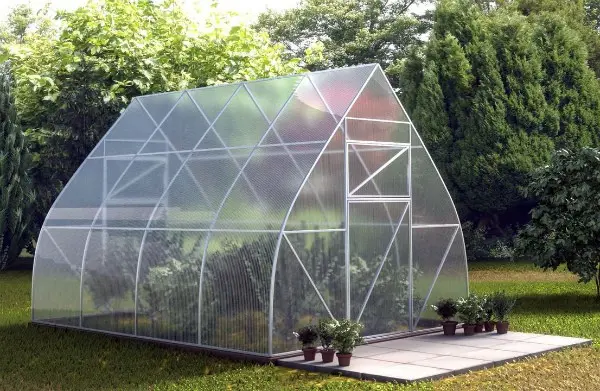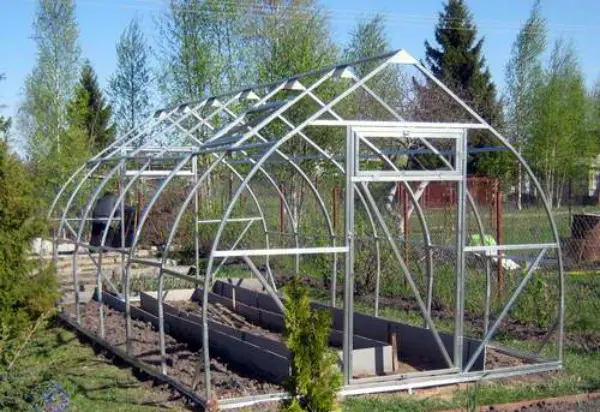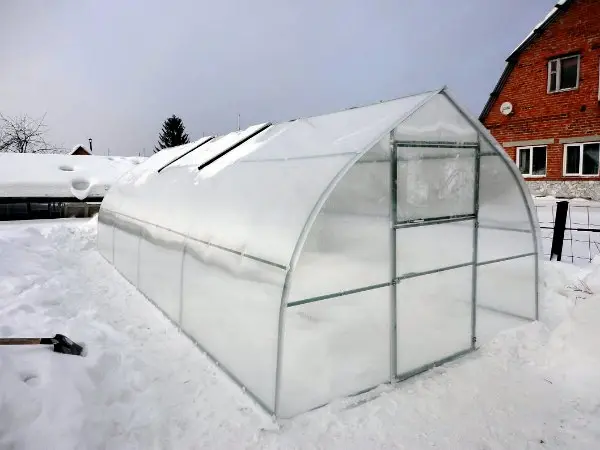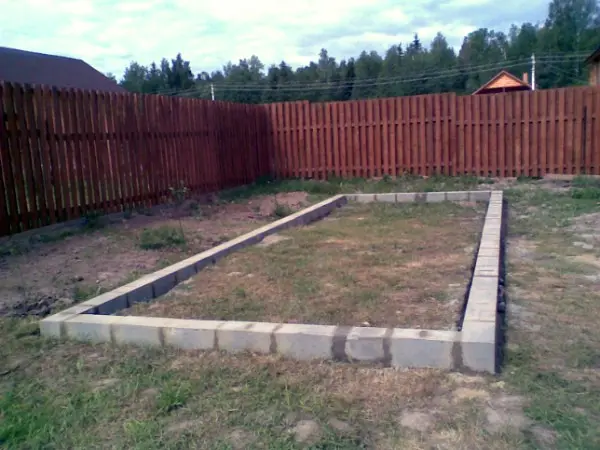Contents
Polycarbonate greenhouses are the best purchase for homeowners. One of these types is the Kapelka greenhouse, which is equipped with this modern covering material, so gardeners interested in high yields will appreciate it. However, when buying a finished greenhouse, you need to keep in mind the build quality. And often, a do-it-yourself design is in no way inferior in appearance and duration of operation to the work of craftsmen and specialists.
Greenhouse features
To date, many manufacturers offer various models of polycarbonate greenhouses. But the choice of a greenhouse still needs to be approached seriously and with special care. Even with minor violations of the design and features of the forms of models, strong changes in thermal insulation properties are possible, unfortunately, not for the better.
A droplet is a high-quality greenhouse that meets all the requirements and is made from eco-friendly materials. This is a reinforced greenhouse that perfectly withstands various weather conditions. The shape of the greenhouse was developed directly by specialists, taking into account the peculiarities of the winter season.

This is a unique, strong and durable polycarbonate product, characterized by the following features:
- A peculiar form of construction that resembles a drop. It is because of the specific structure that the greenhouse got its name – Drop. Thanks to this constructive solution, snow mass does not accumulate on the roof of the building, which significantly reduces the risk of breakdowns. In addition, the shape of the reinforced greenhouse increases the level of stability and strength of the structure, thanks to which the structure can withstand even strong gusts of wind.
- Reinforced frame, for which the manufacturer uses steel profiles, and therefore the structure can withstand heavy loads. In addition, power is provided by a special fastening of all arcs – specially reinforced transverse elements.
- A unique coating of all major parts with an anti-corrosion solution that guarantees a reduction in rust formation, which significantly extends the life of the greenhouse.
- Covering material – polycarbonate, characterized by high strength. Even with a strong mechanical impact on the greenhouse, this coating does not form fragments. It should also be noted that the material is protected from the effects of ultraviolet rays – this significantly increases the service life. After all, everyone knows that under the influence of the sun, polycarbonate begins to turn yellow after a few months, so it does not transmit light well. In this case, no such problem will occur.
- The unique frame scheme – a rectangular section of 20 x 20 or 20 x 40 mm with a wall thickness of 2 mm allows the structure to withstand heavy loads. The distance between the arcs is 65 cm, and therefore the structure is very stable.

In addition, the Kapelka greenhouse has an important feature – a change in the long size of the structure, which can be adjusted by hand.
Each gardener can choose the appropriate size of the greenhouse – from 4 to 12 m. The height of the structure remains unchanged – 2 m 40 cm, and in width – 3 m.
Advantages and disadvantages
Any greenhouse, regardless of what material it is made of, has its own advantages and disadvantages. The manufacturers of the Kapelka design took into account many wishes of gardeners, in connection with which they managed to develop a greenhouse with a suitable microclimate for growing plants. Many gardeners who have tested this model have confirmed that the number of pluses significantly exceeds the possible minuses, and some people could not even name at least one manufacturer’s defect.

The advantages include:
- frame with a polymer coating, characterized by durability and strength;
- a unique shape of the greenhouse that does not need constant snow removal in the winter season;
- the ability to adjust the length, two-meter inserts allow you to extend the building to the required size, depending on the needs;
- delimitation of the internal space with the help of special partitions;
- supply of end parts with vents and doors, which makes it possible to improve and facilitate the care of plants, and also makes it possible to control the temperature regime;
- super strength;
- ease of assembly with your own hands;
- the presence of the necessary equipment, which includes the base, fundamental pegs, allowing installation directly on the ground.
Some gardeners who used this model of a reinforced greenhouse voiced one single drawback, which is not critical, according to them. This is a small height of the walls of the structure. However, due to the special shape without sharp corners, the plants still stretch upwards, which minimizes this disadvantage.

Installation
The installation of the structure is quite simple. Included with any product is a drawing with instructions for assembling the structure. Adhering to all the rules and relying on the drawings, you can quickly assemble a greenhouse with your own hands, without the help of specialists.
The first thing to start with is to establish a fundamental foundation. It is required to make markings along which the upper part of the soil is removed. After the done actions, the soil is compacted. The main stage is the laying of a layer of geotextile and the implementation of a sand and gravel cushion.
If there is a need for a light wooden base, then the bars measuring 10 x 10 cm are installed in the form of a frame. If you want to make a more reliable foundation, you can use the old and proven method – pouring concrete using formwork. After you have dealt with the base for the greenhouse, you need to proceed to the direct assembly.

Mounting the frame with your own hands requires a certain sequence, as stated in the attached instructions. For convenience, the manufacturer created a drawing with an algorithm of actions. With the help of self-tapping screws, all arcs and end parts, which are equipped with doors, are attached to each other. It is at this stage that it is recommended to perform sequential actions without any haste. After all, this module must be attached to the foundation as evenly as possible.
After installing the ends, you can proceed with the installation of modules with vents. Initially, they are attached to the foundation, after which they are fastened between the walls in the upper part of the structure. Thus, fixation occurs not only between the modules, but also at the foundation.
When installing a greenhouse with your own hands, do not forget that polycarbonate can only be bent across the stiffeners. Otherwise, the material may become unusable.

Care
A greenhouse called Droplet does not require special care. Polycarbonate is a modern and durable material. Therefore, the shading process can be carried out not by stretching the fabric over the greenhouse, but by spraying the greenhouse with ordinary chalk.
In the autumn season, it is necessary to remove plant residues from the greenhouse and tillage. It is recommended to disinfect the structure and preserve it for the winter period if you do not plan to use the greenhouse at this time of the year.
Video “Assembly, installation, installation of the Kapelka greenhouse”
Get the most complete video instruction on assembling the Kapelka greenhouse frame, installing polycarbonate and installing the entire structure.









